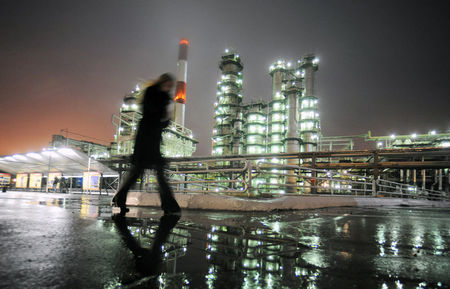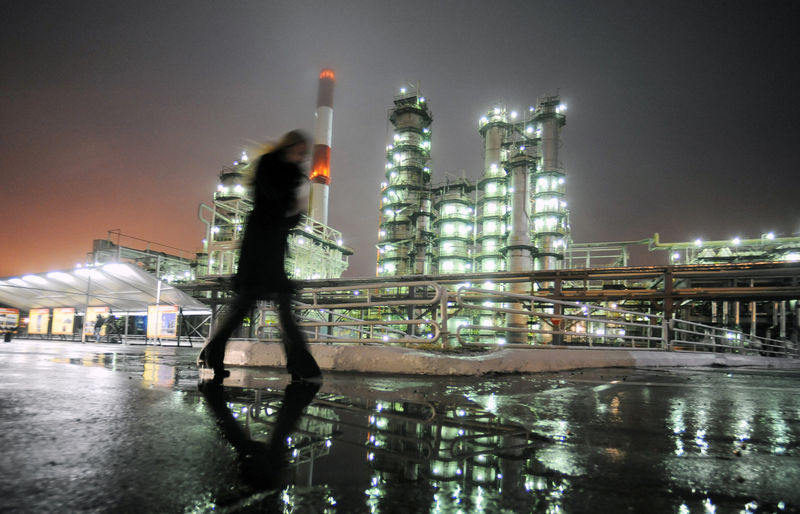Commodities
Oil rebound pauses on reality check over impact from Israel-Hamas war


© Reuters.
Investing.com – Oil has only traded a day since the escalation in Israel-Hamas fighting, yet traders have already hit the pause button on the market’s rally, for a reality check on the impact from the conflict.
After Monday’s run-up of more than 4% in prices of both U.S. crude and its UK peer Brent, the two oil benchmarks traded in the negative by Tuesday’s noon hour in Asia. The pause on the oil rally came in the absence of credible estimates on how many barrels of oil produced, traded or shipped out of the Middle East would be stranded by latest tensions in the region.
By 12:01 local in Singapore (00:01 ET), New York-traded West Texas Intermediate, or , crude for delivery in November was down 36 cents, or 0.4%, to $86.02 per barrel.
On Monday, the U.S. crude benchmark settled up $3.59, after rising almost $4.50 at the session high to reach $87.23.
London-traded for the most-active December contract was down 34 cents, or 0.4%, to $87.81.
In the previous session, Brent closed up $3.57, after also rising nearly $4.50 at the session high like WTI to reach $89.
It was important to put the brakes on any oil rally to prevent the market from getting ahead of itself again, like it did in September, despite concerns about global inflation and stagnating European growth, said John Kilduff, a partner at New York energy hedge fund Again Capital.
“Don’t get me wrong, the war that’s going on now is big,” said Kilduff, who’s also a veteran commentator on the impact of Middle East strife on oil markets. “But is the oil trade really getting stifled by this conflict, aside from the squeeze on supply already being applied by OPEC+? Or is oil going up just in sympathy with overall tensions in the region.”
“It’s alright to assign some geopolitical risk to oil in situations like this, but not to the extent that the geopolitical risk itself becomes a free lunch for the trade,” said Kilduff. “As of now, there’s no proof that there’ll be a meaningful reduction in barrels because of this war alone and that includes any clampdown on oil exports from Iran, which is a supporter of all things Hamas. Until and unless we get evidence of that, crude prices should not trade much higher than where they did last week.”
Oil prices hit five-week lows last week, with WTI falling to $81.50 and Brent plumbing $83.44.
In support of oil markets on Monday, Saudi Energy Minister Abdulaziz bin Salman said production cuts by the global group of oil producers known as OPEC+ will continue.
OPEC+ says cuts will continue, but no word on Iranian supplies
The Saudis and Russians, who jointly lead the OPEC+, are withholding a daily supply of 1.3 million barrels between them, while the rest of the 23-nation alliance is contributing to a squeeze of another 2 million barrels or more.
“I honestly believe that the best thing I could say is that the cohesion of OPEC+ should not be challenged,” Abdulaziz said on the sidelines of a climate conference in Riyadh. “We’ve been through the worst, I don’t think we will have to go through any terrible situation at all,”
“Yes, we may be delayed with a decision on what to do, but I would not forfeit the precautionary approach, even if it goes beyond a month or two, or three or four months, or five months,” he added.
But there was no word about any change to Iranian supply, which is what the market was really looking out for.
Since late 2022, Washington has turned a blind eye to surging Iranian oil exports, bypassing American sanctions. The priority in Washington was an informal détente with Tehran so as to allow the world more in the advent of the OPEC cuts.
As a result, Iranian oil output is estimated to have surged nearly 700,000 barrels a day this year – the second-largest source of incremental supply in 2023, behind only US shale oil. The White House could enforce those sanctions against Iran now in support of Israel.
Early last week, oil hit more than one-year highs of $95 for WTI and $97 for Brent, responding to aggressive OPEC+ cuts.
From there, the market tumbled on a backdrop of macro and economic factors as hit 16-year highs and the soared to a 10-month peak while consumption of gasoline — the No. 1 fuel product in the United States — hit a seasonal low of 25 years. Specifically, US crude fell 9% last week and Brent 11%, the biggest weekly slump since March. It was a selloff deeper than any weekly rally in oil over the past three months.
Commodities
Oil prices rise; U.S. crude inventories plunge, Russia-Ukraine truce eyed
Commodities
India’s Reliance to stop buying Venezuelan oil over US tariffs, sources say
Commodities
Oil prices climb on Venezuela supply worries

 Forex3 years ago
Forex3 years agoForex Today: the dollar is gaining strength amid gloomy sentiment at the start of the Fed’s week

 Forex3 years ago
Forex3 years agoUnbiased review of Pocket Option broker

 Forex3 years ago
Forex3 years agoDollar to pound sterling exchange rate today: Pound plummeted to its lowest since 1985

 Forex3 years ago
Forex3 years agoHow is the Australian dollar doing today?

 Cryptocurrency3 years ago
Cryptocurrency3 years agoWhat happened in the crypto market – current events today

 World3 years ago
World3 years agoWhy are modern video games an art form?

 Commodities3 years ago
Commodities3 years agoCopper continues to fall in price on expectations of lower demand in China

 Economy3 years ago
Economy3 years agoCrude oil tankers double in price due to EU anti-Russian sanctions























